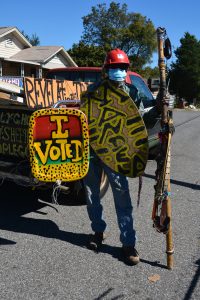
From the June 2021 Desktop News | At first glance, Joe Minter’s backyard looks like an assortment of metal and building materials. But for Minter, a found-object artist in Birmingham, this sea of rust and steel tells the story of his life, and a cultural movement, in a collection he calls “African Village in America.” And now, researchers at The University of Alabama are helping Minter preserve his stories forever.
Minter is supported by Souls Grown Deep, an organization that helps preserve and promote Black artists in the South. Their focus has shifted from displaying art in traditional museums and galleries to keeping pieces in their original locations and communities. To that end, the group reached out to the UA geography department, and Eric Courchesne, the Geospatial Services Manager, to see if he and a team of UA faculty and staff members could help preserve Minter’s legacy. For Courchesne, it was a no-brainer.
“As soon as I saw Joe’s work and met with him, I knew UA had to get behind it,” Courchesne said. “It’s incredibly important work, and at this moment in history and in Joe’s life we felt like now was the time to preserve it. The University has these resources, and we have a unique opportunity to do good with those resources—to contribute to society in a meaningful way.”
Courchesne and his team, including UA’s Dr. Hongxing Liu, Yang Liu, and San José State University’s Dr. Bo Yang, used drones typically used to map rivers and their contents to take a full scan of Minter’s collection, flying both over and through the collection, taking detailed images and videos of each piece. Over the next year, Courchesne’s team will process the images, then send them to associate art history professor Dr. Rachel Stephens, Paul R. Jones Collection curator Emily Bibb, and art history master’s student Lizzie Orlofsky to curate, while incoming history post-doc Jasmin Howard interviews Minter to further document his story.

A Black man born and raised in Birmingham, Minter experienced segregation during his childhood and worked a variety of jobs before being drafted into the Vietnam War. When he returned, the city he knew as home was the center of the Civil Rights movement. Over the next decade, Minter observed history in his hometown while working in Birmingham’s booming steel industry. He left in 1979 after his eyes started to fail because of asbestos. Since then, he has used art to tell his life story using the found materials of his past.
“Joe lived every part of what his art is—from the materials to the subject matter, he lived it,” Courchesne said. “He pulled iron out of the ground to support the steel industry in Birmingham. He lived through the Civil Rights movement. And so when he pulls bricks from the bombed 16th Street Baptist Church to build a piece, it’s personal. He uses materials in a way that I think is representative of his personal experience, and more broadly, of the cultural experience.”
The UA team hopes to have Minter’s work richly documented online by fall 2022 so the whole world can experience it, and to support the preservation of his collection. They also hope this serves as a model for future projects preserving Black art in the South.
For more information on Minter’s work and life, visit the Souls Grown Deep website.